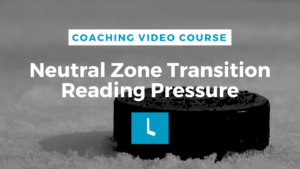(Transcribed from How to Play Hockey: Our Minor Hockey Coaching Course.)
The North American game is referred to as a North and South game. Players go hard up and down the ice. European hockey has helped us realize that heading East or West can often help us create time and space, reduce the risk of injury and give our teammates the support they need. A supportive skating tactic helps your team become a better puck possession team with players with good habits. Flat skating puts you in a better position to get the puck and to then make a play.
[maxbutton id=”2″ ]
This Theory is part Geography.
Picture the ice West and East, South and North. Flat skating is moving across the ice, West to East and East to West in order to support the puck. This is very similar to the middle support which we talked about in an earlier video.
Let’s say the defense has the puck and moves it to his/her staggered partner and the center was supporting here, instead of heading North and receiving a pass looking over his/her shoulder. He/she should support flat West East as long as possible. The entire time you are presented a target by this defense and an opportunity to make that pass.
The other good thing about this is, if you do get forechecking pressure here as the pass comes and you are moving flat, you are able, instead of heading North and getting the crunch here in content hockey, to fade off a little bit and get away from that forechecker. If your wingers are open or perhaps your defense is open, need to get rid of the puck. When you are forced to go North and South, you are limited in the amount of space. If you are going to make this pass and you start to look over your shoulder you create a dangerous compromised position.
Advantages so far:
- You increase the time your teammate has to present the target.
- When you do receive it you relieve pressure yourself by fading away from that forechecking pressure. We want to eliminate these opportunities to get checked with the big body check or just with a stick check. In non-contact hockey in the middle of the ice where we are heading up-ice, it might be the winger. If this defender has the puck and the center happens to get it, keep curling his/her way and as the winger switches lanes perhaps the winger can bust across flat and be able to get the puck.
Let’s switch gears for a moment and think about the defensive zone. Let’s say our defense has gone D to D. Once again the center is delayed coming in with timing flat across the ice. S/he can either receive it and chip it out to the winger or receive it and continue on with a little shoulder check. You will know how much pressure you have and how much time you have to redirect or pass that check .
Flat skating is a way to slow down the players rather than going an hour in one direction looking over your shoulder. It increases the time you are available to your teammate to receive that pass.
Looking to download half ice hockey practice plans, goalie drills for teams (not a goalie coach?!) or small area games drills? We’ve got you covered too. Click here. Perfect for recreational level coaches.





